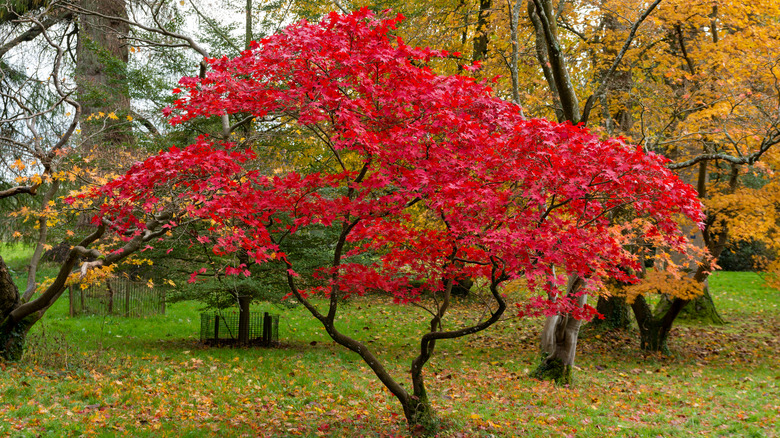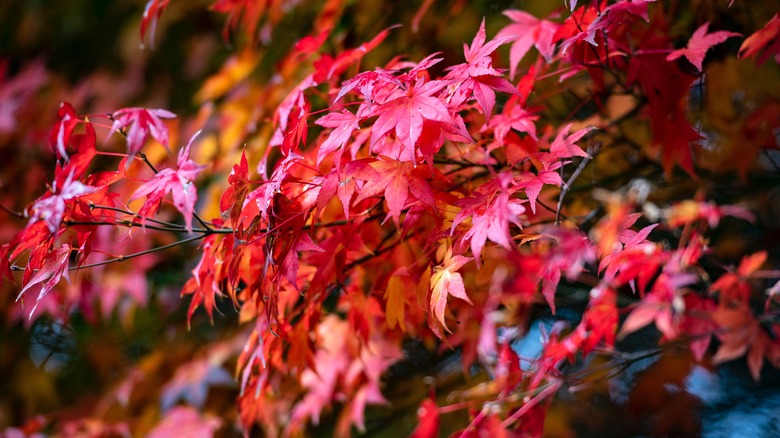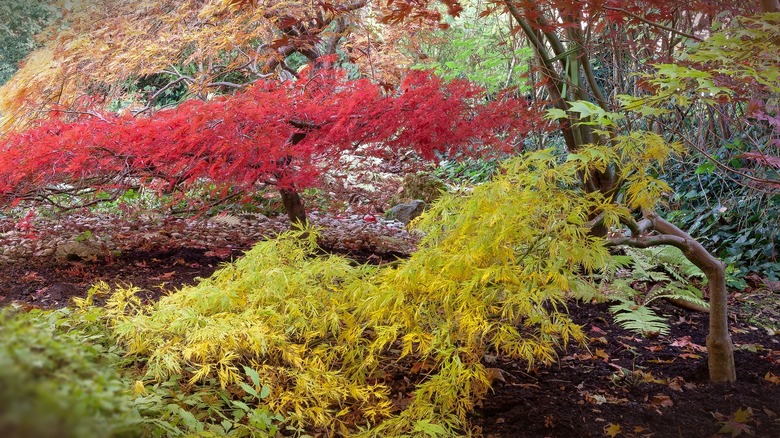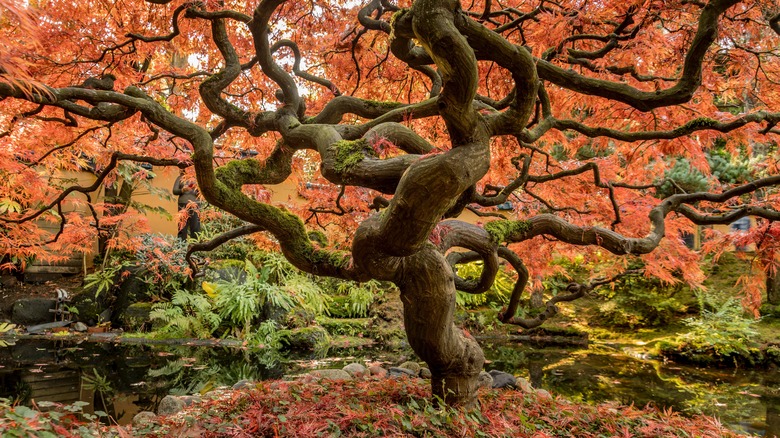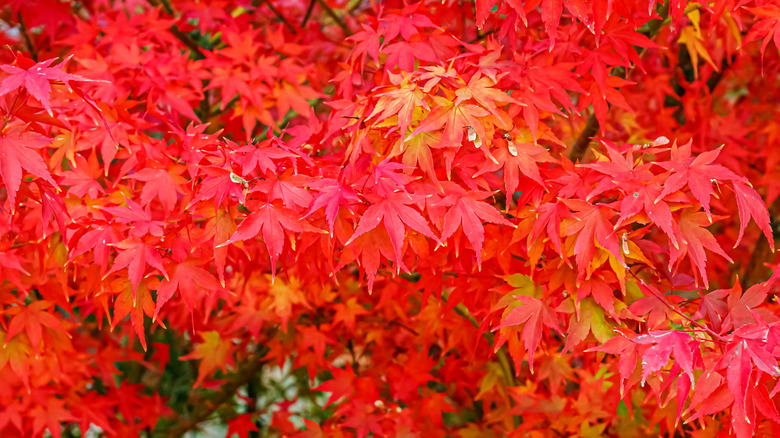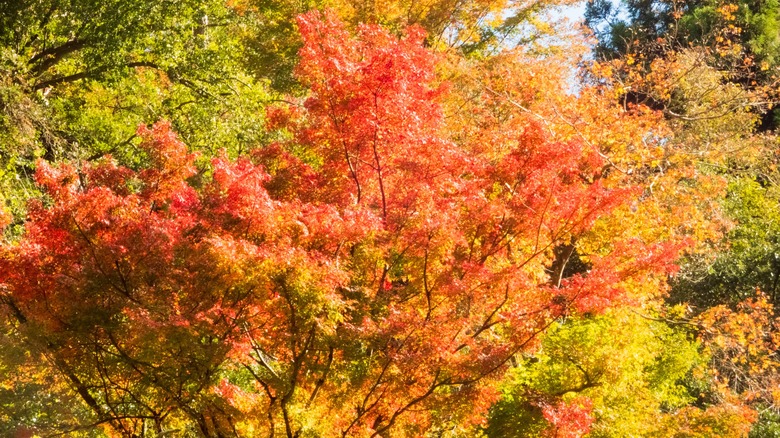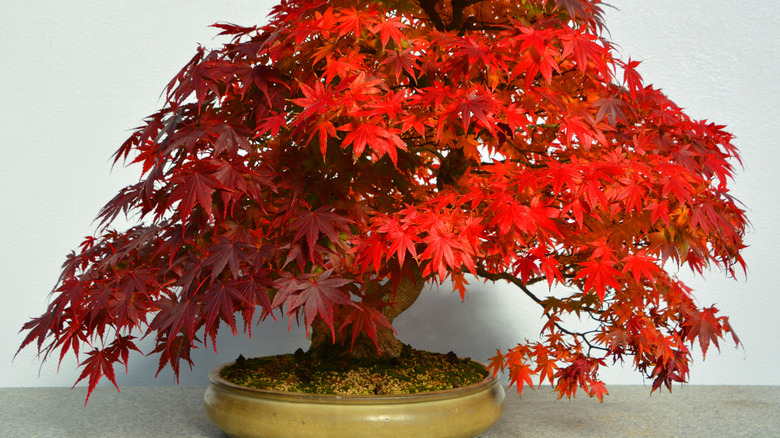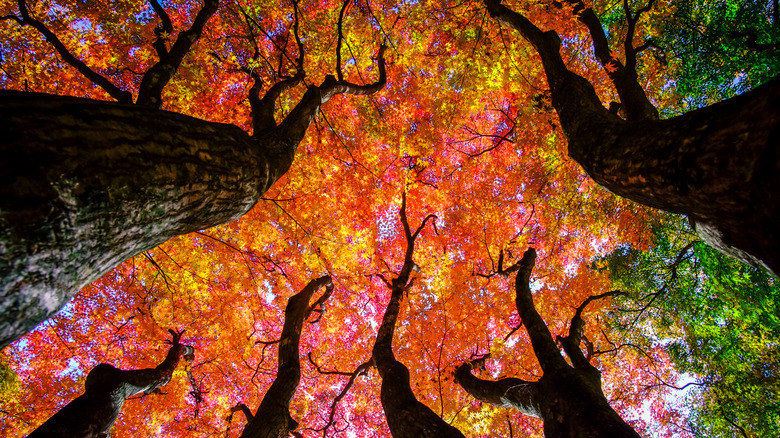How To Grow And Care For Japanese Maple Trees
The Japanese maple tree is a very popular tree, both indoors and out. Striking red leaves distinguish this tree from a traditional maple, and it's an excellent addition to your garden or great to keep as a bonsai. According to The Spruce, the Japanese maple tree is native to East Asia and is displayed popularly through Japanese landscaping and art. Specifically, this tree originally hails from Japan, China, and Korea, as well as parts of Mongolia and Russia. The Japanese maple is popular in the U.S., too, and is even featured on the Yale Nature Walk.
Japanese maple trees are incredibly versatile, ranging from bonsais and shrubs to up to 25-feet-tall trees, and come in a variety of shapes, colors, leaf patterns, etc. They can be found in a variety of species, too, and can be grown in USDA hardiness zones 5 through 9, which includes a large majority of the U.S. Read on for information on how to care for this majestic tree.
How to use Japanese maple trees in garden
Japanese maple trees can be grown in most of the U.S., and make an excellent addition to your garden. According to Wayside Gardens, you should plant Japanese maple tree in the fall, roughly a month before the ground is frozen. Japanese maples will be just fine during winter months, but spring is the most precarious season for the tree. The reason? Japanese maples will start to sprout leaves early due to rising temperatures and come out of its dormant season, but spring frosts can be very dangerous. Keep an eye on the weather and make sure to cover your tree if frost is forecasted.
Another threat to the Japanese maple is strong winds. The fragile leaves and branches will not tolerate high winds, so don't plant it in areas that receive frequent crosswinds. Also, be careful to protect the tree when bringing it home from a nursery.
When landscaping with Japanese maples, Gardenia suggests plants that are also comfortable in moist, slightly acidic soils, such as mountain laurel, azaleas, Christmas rose, crocus, daffodils, irises, coral bells, ferns, and hostas. Play around with the color varieties of different flowers, shrubs, and foliage. Pair the bright Japanese maple with the rich tone of coral bells, or contrast the red leaves with a bright green hosta. Japanese maples will change from brighter reds to deeper purples and bronzes as the seasons change, which when accompanied by other plants, will create a stunning visual progression.
How to grow Japanese maple trees
The easiest option for growing a Japanese maple outdoors is to buy a young tree from your local nursery and plant it in late fall. Mature Japanese maple trees, however, will produce a fruit called samara, which can be harvested for its seeds and replanted. Many Japanese maple trees have been grafted, meaning that planting a seed from that tree will not result in that tree being grown, warns Gardening Know How.
To harvest seeds from the samara fruit, look for the flying, brownish bits hanging off of a mature tree — you can even harvest fallen fruits. Whether you want to start your seeds indoors in a pot, or outdoors in the ground, you will need to start by pretreating them. Remove the winged parts of the fruit and soak the seeds in warm water for 24 hours. If you would like to plant your seed during the winter — provided your climate produces cold winters — simply plant the seeds in the ground before it freezes. If you need to stratify your seeds, place them in a plastic bag with a little bit of soil, ventilate the bag, and store it in your fridge for the winter season. Come spring, you can plant the seeds in a pot or the ground.
How to care for Japanese maple trees
With a plethora of variations, Japanese maple trees have an equally wide array of care needs. Before diving headfirst into growing one of these trees, make sure you're attending to the specific needs of your cultivar.
Generally, Japanese maple trees prefer filtered sun to partial shade, with some varieties even preferring full shade (via The Spruce). This tree is not suitable for full sun. Wayside Gardens warns that burnt leaves are a good sign your tree is receiving too much direct sun, while muted leaf colors may indicate too much shade. Additionally, ensure you're planting this tree in well-draining soil, as it enjoys frequent waterings. Consider adding mulch around the base of the tree to encourage moisture. This will also help stunt weed growth, according to Gardening Know How.
As for humidity and temperature levels, check your specific cultivar — different varieties will have different preferences, largely dependent on your USDA hardiness zone. If you would like to fertilize your Japanese maple tree, use a fertilizer low in nitrogen once it's out of dormancy, stopping in May to encourage it to change colors for the fall (via Garden Design).
Japanese maple tree varieties
Choosing a Japanese maple tree to grow will have a lot to do with your location and climate. However, with over a hundred varieties with different care needs, choosing which variety of this gorgeous, easy to maintain tree to put in your backyard can be overwhelming.
Here are just a few stunning varieties to help simplify the choosing process, as per Gardener's Path:
-
Beni Kawa: This variety will only grow to around 10 feet tall, has green leaves that transition to a yellow color in the fall, and is unique for its bright maroon branches.
-
Crimson Queen: As its name suggests, this variety is distinguished by its dark crimson leaves in the fall, which will lighten to a vibrant red in the spring and summer.
-
Hogyoku: This variety is as gorgeous as any other variety in the warmer weather, but will turn a stunning, rich shade of orange in the fall.
-
Velvet Viking: A smaller variety, this plant will most often be seen in gardens as shrubs or kept in containers, and stuns with its dark red, feathery leaves.
-
Villa Taranto: Another dwarf variation, this Japanese maple tree has a more distinct leave design, with spider plant-like crimson leaves.
Are Japanese maple trees toxic?
Japanese maple trees are completely non-toxic to humans and all domestic animals except horses, says Hunker. As a matter of fact, deep fried Japanese maple leaves are a popular snack in Osaka called momiji tempura (via The Spruce). There are also a variety of uses for the tree's sap, according to Joy Pet Products, including flavoring drinks or as an alternative sweetener. Although the sap is edible, however, SFGate warns that the tree's sap can cause irritation to the skin. Take care to wash your hands after coming in contact with Japanese maple tree sap if your skin is sensitive or prone to rash and irritations.
Many people wrongfully assume Japanese maple trees are toxic. This is due to a similar tree of a different genus, the red maple tree, which is known for growing a toxic fungus on its bark. This fungus does not affect the Japanese maple tree.
How to repot Japanese maple trees
Japanese maple trees do not have to be grown in the ground; many dwarf varieties are commonly grown outdoors in containers. Japanese maples can be grown indoors, but this is a rare and difficult occurrence. Hunker warns that the plant will need to experience its winter seasonal dormancy, and be moved to an unheated area of your house or simply relocated outside. It can also be susceptible to more insects than it would outdoors. This tree is also often cultivated in bonsai form, though this is an entirely different care process.
The Royal Horticultural Society suggests repotting Japanese maples every couple of years at either the beginning or end of its growing season. Older trees will need to have their root systems assessed and pruned by removing the bottom 2 inches of its root ball. When repotting your Japanese maple, gently break up the root system. Add compost to the bottom of the container to ensure the tree sits at the same depth as before, then fill with soil and water. The Spruce recommends using a loamy, slightly acidic soil mixture. During the winter, make sure to cover the base of the pot to avoid exposing the roots to frost.
Common Japanese maple tree pests and diseases
Japanese maple trees are not invulnerable to bugs or sickness. However, knowing the signs of an infestation or disease, and how to prevent them, is vital in preserving your tree. The most common and dangerous bug to the Japanese maple tree are Japanese beetles (via Gardening Know How). Fortunately, there are a variety of ways to combat these pests. One way is to simply pick them off, according to HGTV. Some people suggest traps, though be warned: Traps, while effective, may attract more beetles to your tree. The most effective method of treatment is using a pesticide. Other common pests include mealybugs, mites, aphids, and borers. Young trees are more vulnerable to bugs. Regularly apply pesticides to prevent infestation.
When it comes to diseases, Japanese maple trees are most susceptible to fungal infections. One of the most common ailments is canker, which will result in large dead patches in the wood. The tree can often heal itself, but severe infections can be fatal. Another fungal infection that may affect your Japanese maple is verticillium wilt, which will manifest in yellowing leaves. To avoid infection altogether, make sure to prune your tree yearly, discard dead leaves and fallen twigs, and replace the gardening mulch on an annual basis.
